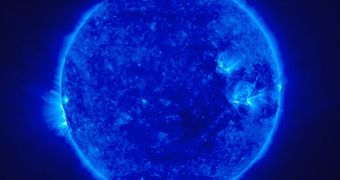The American space agency's Solar Terrestrial Relations Observatory (STEREO) twin observation spacecraft has allowed experts at NASA to observe a solar storm in 3D for the first time. This could bring about a new era of knowledge on how our star erupts, and what the underlying issues behind its coronal mass ejections, or CME, are.
Understanding these phenomena is crucial, because, if they come towards the Earth, then the astronauts in orbit are in grave danger. Also, power grids and electrical devices in general are very susceptible to being burnt by the intense radiation, which could cause panic and looting in the streets.
Astrophysicists say that CME are mostly made up of plasma and magnetic energy, which can have adverse effects on our planet, if they can get past our protective shield – the magnetosphere. “We can now see a CME from the time it leaves the solar surface until it reaches Earth, and we can reconstruct the event in 3D directly from the images,” Naval Research Laboratory Solar Physicist Angelos Vourlidas, who is also the STEREO-based Sun Earth Connection Coronal and Heliospheric Investigation (SECCHI) project scientist, explained.
“The evolution in imaging capability since the discovery in 1971 to now is just astounding. It took 44 minutes to read out the 256x256 pixel image (worse than most cell phone images), whereas now it takes a few seconds to read out the current 2048x2048 pixel image,” LASCO and SECCHI experiments principal investigator Russ Howard, who is also a solar physicist at the NRL, added, PhysOrg reports. The NRL team has always been at the forefront of CME-related studies, ever since the phenomena were first discovered, in 1971, by the Laboratory's own OSO-7 telescope.
Up until this point, the only way for astronomers to observe a CME was to identify the time when it was generated inside the Sun, and then simply wait for three to seven days until it reached the Earth, to see exactly how strong it was and what would happen. However, this type of analysis has been replaced by a more proactive one, where STEREO supervises forming CME even before they leave the Sun, and then throughout the journey they make to our planet.

 14 DAY TRIAL //
14 DAY TRIAL //